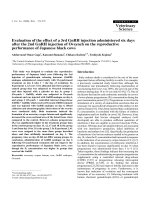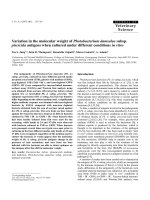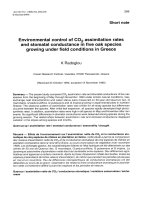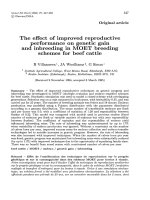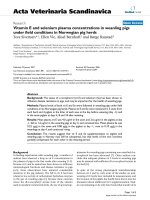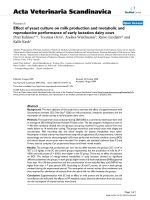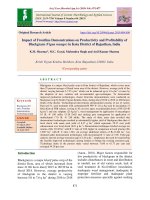Reproductive performance of buffaloes under field conditions in Bundi district of Rajasthan, India
Bạn đang xem bản rút gọn của tài liệu. Xem và tải ngay bản đầy đủ của tài liệu tại đây (147.39 KB, 5 trang )
Int.J.Curr.Microbiol.App.Sci (2017) 6(4): 595-599
International Journal of Current Microbiology and Applied Sciences
ISSN: 2319-7706 Volume 6 Number 4 (2017) pp. 595-599
Journal homepage:
Original Research Article
/>
Reproductive Performance of Buffaloes under Field Conditions
in Bundi District of Rajasthan, India
B.L. Dhaka*, G.S. Meena and N.L. Meena
Krishi Vigyan Kendra, Bundi - 323001 Rajasthan, India
*Corresponding author
ABSTRACT
Keywords
Buffalo, Dairy,
Reproductive
performance,
Production.
Article Info
Accepted:
06 March 2017
Available Online:
10 April 2017
The study was conducted during 2015-16 in Bundi district of Rajasthan to
assess the reproductive performance of buffaloes. A multi-stage sampling
design was used to select the 180 sample households. The selected
respondent farmers were interviewed personally using a well structured and
pre-tested interview schedule. The results of the study indicate poor
reproductive performance of buffaloes. Further, anestrous and repeat
breeding were the most prevalent reproductive disorders in buffaloes in the
study area.
Introduction
Livestock plays an important role in the
agricultural sector. It contributes directly and
indirectly to agricultural production. It
important source of livelihood and generates
regular income to the farmer. Despite of the
vital importance of livestock and dependency
of farmers, the productivity is far below than
the actual potential. Several factors are
responsible for this low production.
Reproduction is one of the most important
considerations determining the profitability of
dairy
animal
production.
Efficient
reproductive performance of animal is an
important prerequisite for efficient livestock
production. This is essential for the
production of milk, as well as to provide
replacement animals. The performance of
dairy production system all relies on the
acceptable level of reproduction. Thus, a need
was felt to understand the current status of
reproductive management of buffaloes in
Bundi district of Rajasthan. The information
obtained from this study could serves as the
basis for the exploitation of genetic potential
to further dairy development in this area.
Materials and Methods
The study was conducted in Bundi district of
Rajasthan. A multi-stage sampling design was
used to select the sample households. In first
stage, all six blocks of the Bundi district
namely, Bundi, Hindoli, Nainwa, K. Patan,
Talera and Lakheri were selected. In second
stage, three villages from each selected block
were selected purposively to ensure good
representation of the selected block. Thus, 18
villages from six blocks were selected.
595
Int.J.Curr.Microbiol.App.Sci (2017) 6(4): 595-599
Finally, in third stage, 180 farmers,
representing ten households from each
selected village, were selected. The selected
respondent
farmers
were interviewed
personally with the help of a well-structured
and pre-tested interview schedule. The data,
thus collected, were subjected to appropriate
statistical analysis.
resulted from the low level of management
and poor feeding of calves and heifers at the
earlier stages, which consequently had
reduced growth rate and delayed puberty. The
interval between calving and subsequent
conception, known as service period, was
widely varied in study area. An average 420
days service period was observed in study
area.
The reproductive problems responsible for the
low productivity of buffaloes production
system were identified through a pilot study.
The intensity of the identified problems in the
actual field situation was measured to prove
their validity. The quantification of data was
done by first ranking the problems based on
the responses obtained from the respondents
and then calculating the Rank Based Quotient
(RBQ) (Sabarathnam, 1988), as follows:
It was observed that two or more services
were required to conceive for majority of
buffaloes. The mean of the number of
services per conception required was 2.20.
The calving interval in this study was
observed much longer. The mean calving
interval recorded was 560 days which clearly
reflects evidence of poor reproduction
performance of buffaloes. The longer duration
of calving interval observed might be due to
poor feeding and production management.
The mean lactation length of 240 days was
recorded. The interval between end of
lactation and subsequent calving is called as
dry period. An average 320 days dry period
was recorded in this study.
Σfi(n+1-i)
R.B.Q. = -------------- X 100
Nxn
Wherein,
fi
= Number of farmers reporting a
particular
problem
under
ith
rank
N
= Number of farmers
n
= Number of problems identified
Breeding practices
The results regarding various breeding
practices followed by the buffalo farmers are
presented in table 2. It was noticed that
majority of farmers (90 %) were rearing non –
descript buffalo. Bidwe et al., (2009) also
reported similar practices. Table 2 further
indicates that bellowing and vaginal discharge
were the most common symptoms observed
by majority of respondent farmers for heat
detection in addition to observing the frequent
urination and mounting on other animal.
Similar observations were also reported by
Brar and Nanda (2004), Tanwar et al., (2012),
Kumar et al., (2014) and Patel et al., (2014).
As far as the method of breeding is
concerned, majority of respondents were
practicing natural service. Only 13.33 %
Results and Discussion
Reproductive performance
An assessment of the reproductive
performance of buffaloes in Bundi district
was performed and findings are presented in
table 1. The results indicate that the mean age
at first service of buffalo heifers was 42
months. With this, the mean age at first
calving was estimated to be 52 months. The
mean estimated age at first calving observed
in this study was too late as compared to
acceptable level. The age at first calving in
good herds was 36 to 40 months (Viswanath,
2002). This large difference might have
596
Int.J.Curr.Microbiol.App.Sci (2017) 6(4): 595-599
farmers were using artificial insemination.
Yadav et al., (2009), Sinha et al., (2010),
Tanwar et al., (2012) and Patel et al., (2014)
also reported similar practices, supporting the
present findings. This situation revealed that
the dairy farmers had bred their animals with
the locally available bull in their village or
vicinity area.
Table.1 Reproductive performance
Parameters
Mean reproductive
performance
Age at first service (months)
Age at first calving (months)
Service period (days)
Services per conception (No.)
Calving interval (days)
Lactation length (days)
Dry period (days)
N
370
336
570
570
570
570
570
Mean
42.00
52.00
240.00
2.20
560.00
240.00
320.00
Table.2 Breeding management practices followed by farmers
Practices
Types of animal
Heat detection method
Method of breeding
Time of insemination
Pregnancy diagnosis
Preventing
exposure
abortifacient agents
Drying off
Record keeping
Particulars
Descript
Non-descript
Vaginal discharge
Bellowing
Vulval swelling
Frequent urination
Mounting on other animal
Allow other animal to mount
Doka
Natural service
Artificial insemination
Before 12 hours
within 12-18 hours
after 18 hours
Yes
No
to Yes
No
Yes
No
Yes
No
597
Number
18
162
83
97
13
17
23
8
11
156
24
19
92
69
13
167
47
133
33
147
29
151
Percent
10.00
90.00
46.11
53.89
7.22
9.44
12.78
4.44
6.11
86.67
13.33
10.56
51.11
38.33
7.22
92.78
26.11
73.89
18.33
81.67
16.11
83.89
Int.J.Curr.Microbiol.App.Sci (2017) 6(4): 595-599
Table.3 Reproductive problems faced by farmers
Problems
Anestrous
Silent estrus
Repeat breeding
Prolaps of uterus
Retention of placenta
Abortion
Dystocia
Ranks
I
II
54 42
37 33
46 38
21 28
12 14
7 19
3 6
III
33
29
32
31
27
15
13
IV
19
28
34
32
25
23
19
Time of insemination after heat is very crucial
aspect in conception; the farmers of the
survey areas were inseminating their animals
mainly within 12-18 hours (51.11 %) of heat
manifestation however 38.33 % of farmers
inseminating their animals after 18 hours of
heat. This result was in agreement with Patel
(2014), Tanwar et al., (2012) and Sabapara et
al., (2010) who reported that the natural
service or A.I. was performed between 12-24
hrs of heat detection by majority of
respondents.
V
11
29
13
24
33
32
38
VI VI
9 12
14 10
12 5
25 19
41 28
38 46
41 60
R.B.Q
0.741
0.666
0.725
0.587
0.486
0.435
0.360
Overall Rank
I
III
II
IV
V
VI
V
Reproductive problems
It is evident from the data in table 3 that
anestrous and repeat breeding were the most
prevalent reproductive disorders in buffaloes
in the study area, based on RBQ which ranked
first and second serious problems,
respectively. The observed prevalence of
reproductive disorders is similar to previously
reported studies (Rabbani et al., 2010, Meena
and Malik, 2009; Hedaoo et al., 2008;
Agarwal et al., 2005 and Nanda et al., 2003).
Findings of the present study revealed that
there was relatively high prevalence of
reproductive disorders in buffaloes in study
area. This might have been due to poor
management practices followed by the
farmers and inefficient veterinary extension
services.
Pregnancy diagnosis after insemination is
essential step for reducing calving interval at
door step of the farmers. However, a small
number (7.22 %) of the farmers followed
pregnancy diagnosis. These findings are
similar to Patel et al., (2014), Kishore et al.,
(2013), Tanwar et al., (2012) and Dhiman et
al., (1990). It was very interesting to know
that 16.11 percent of farmers were keeping
the breeding records, however, the records
were not complete. Farmers were keeping
records of peak milk yield, date of
insemination and breed of bull or semen straw
used. Patel et al., (2014) also reposted similar
practice.
It is concluded that the reproductive
performance of dairy buffaloes was relatively
poor. The situation of breeding management
practices followed by the dairy farmers was
not satisfactory and this situation might
definitely influence adversely the productivity
of animal. Further, there was relatively high
prevalence of reproductive disorders in
buffaloes in study area. Thus, the government
should support and focus on improving those
important economic performance parameters
of the buffaloes by educating farmers on
improved management practices.
Thus, the overall picture about the existing
breeding management practices followed by
the dairy farmers was not satisfactory and this
situation might definitely influence adversely
the productivity of animal.
598
Int.J.Curr.Microbiol.App.Sci (2017) 6(4): 595-599
Enhancing reproductive performance in
dairy buffalo: Major constraints and
achievements. Reproduction Supplement,
61: 27-36.
Patel, N.B., Kavad, S.D. and Rao, T.K.S. 2014.
Eco-friendly
livestock
management
practices followed by tribal households of
Narmada valley region of India. J. Appl.
Natural Sci., 6(2): 512-518.
Rabbani, R.A., Ahmad, I., Lodhi, L.A., Ahmad,
N. and Muhammad, G. 2010. Prevalence of
various
reproductive
disorders
and
economic losses caused by genital prolapse
in buffaloes. Pakistan Vet. J., 30(1): 44-48.
Sabapara, G.P., Desai, P.M., Singh, R.R. and
Kharadi, V.B. 2010. Breeding and health
care management status of dairy animals in
the tribal area of South Gujarat. Indian J.
Animal Sci., 74(9): 997.
Sabarathanam, V.E. 1988. Manuals of field
experience training for ARS scientists.
NAARM, Hyderabad.
Sinha, R.R.K., Dutt, T., Singh, R.R., Singh, M.
and Bhusan, B. 2010. Studies on breeding
and health care management practices in
rural, semi-urban and urban areas of Bareily
district of Uttar Pradesh. Indian J. Animal
Production and Manage., 26(1-2): 11-15.
Tanwar, P.S., Kumar, Y. and Sankhala, G. 2012.
Study on breeding and feeding management
practices followed by members and nonmembers of dairy cooperatives in Jaipur
district of Rajasthan. Indian J. Dairy Sci.,
65(6): 508-513.
Viswanath, C.S. 2002. Handbook of animal
husbandry. ICAR, New Delhi. 1234p.
Yadav, C.M., Bhimawat, B.S. and Khan, P.M.
2009. Existing breeding and health care
practices of cattle in tribals of Dungarpur
district of Rajasthan. Indian Res. J. Ext.
Edu., 9(1): 36-38.
References
Agarwal, S.K., Singh, S.K. and Rajkumar, R.
2005. Reproductive disorders and their
management in cattle and buffalo: A
review. Indian J. Animal Sci., 75(7): 858873.
Bidwe, K.U., Chavan, S.D. and Padghan, P.V.
2009. Studies on breeding management
practices followed by the buffalo owners of
Buldana district of Maharashtra. Indian J.
Anim. Res., 43(1): 71-74.
Brar, P.S. and Nanda, A.S. 2004. Impact of
conventional managemental practices on
reproductive
performance
of
rural
buffaloes. Indian J. Animal Reproduction,
25(2): 94.
Dhiman, P.C., Singh, N. and Yadav, B.L. 1990. A
study of cattle and buffalo feeding and
breeding practices in adopted and nonadopted villages of Hissar district. Indian J.
Anim. Prod. Mgmt., 6: 90-94.
Hedaoo, M.K., Khillare, K.P., Meshram, M.D.,
Sahatpure, S.K. and Patil, M.G. 2008.
Incidence of anoestrus in Surti buffaloes.
Vet. World, 1(2): 46.
Kishore, K., Mahender, M. and Harikrishna, C.
2013. A study on buffalo management
practices in Khammam district of Andhra
Pradesh. Buffalo Bull., 32(2): 97-119.
Kumar, S., Jain, A. and Gupta, A.K. 2014. Studies
on breeding, health care and milking
management practices adopted by the dairy
owners in Shahdol district of MP, India. Int.
Res. J. Biological Sci., 3(10): 32-36.
Meena, M.S. and Malik, B.S. 2009. Participatory
identification of reproductive problems
among dairy animals and constraints faced
by farmers in Haryana. Indian J. Animal
Sci., 79(11): 1172–1175.
Nanda, A., Brar, P.S. and Prabhakar, S. 2003.
How to cite this article:
Dhaka, B.L., G.S. Meena and Meena, N.L. 2017. Reproductive Performance of Buffaloes under
Field Conditions in Bundi District of Rajasthan. Int.J.Curr.Microbiol.App.Sci. 6(4): 595-599.
doi: />
599
